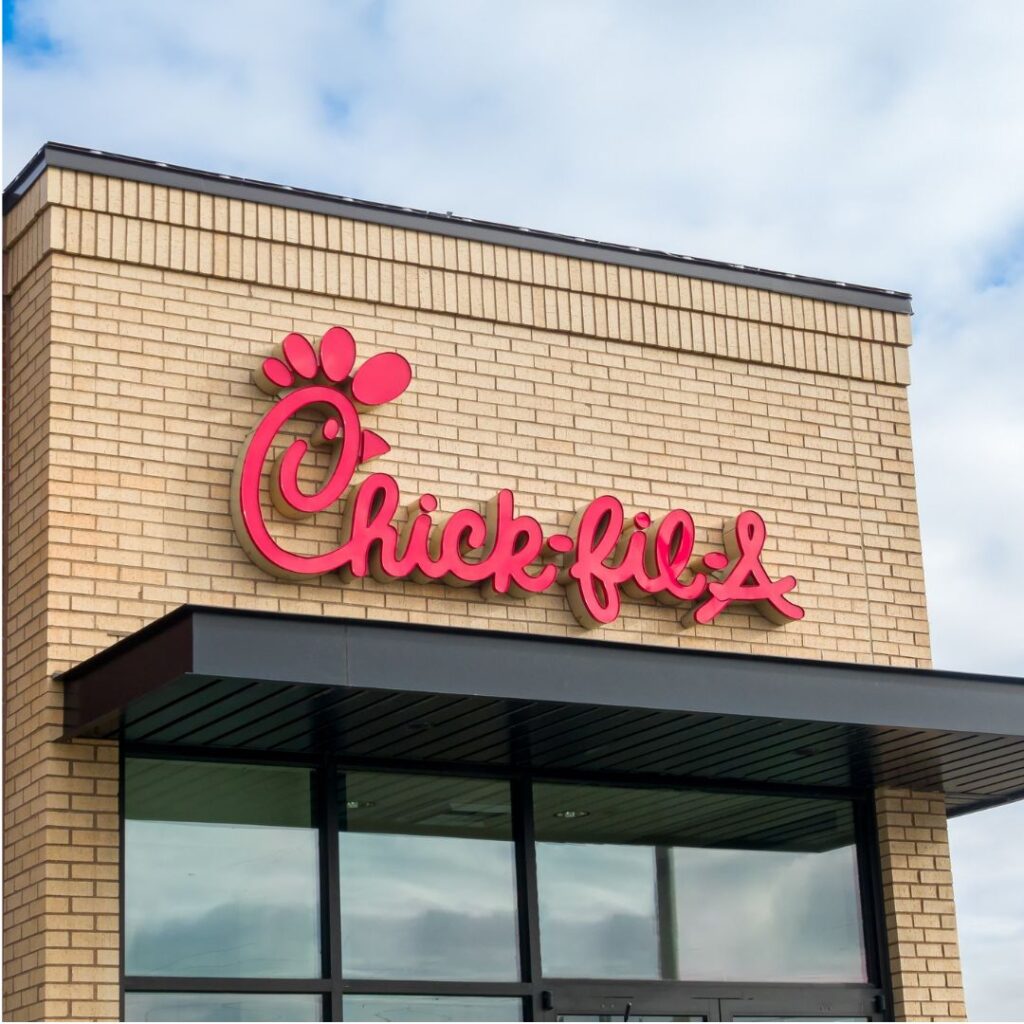Chick-fil-A, known for its delectable chicken sandwiches and exceptional customer service, has not only built a reputation for its food but also for its unique and effective marketing strategies. Over the years, the brand has crafted a distinctive approach to marketing that resonates with consumers and sets it apart from the competition. Let’s delve into the key elements that make Chick-fil-A’s marketing strategy so successful.
1. Iconic “Eat Mor Chikin” Campaign
One of the most memorable aspects of Chick-fil-A’s marketing is the “Eat Mor Chikin” campaign, which debuted in 1995. This campaign features quirky cows encouraging people to eat chicken instead of beef—a humorous and clever concept that quickly captured public attention. The cows, depicted in hand-painted billboards, commercials, and print ads, became cultural icons.
The genius of this campaign lies in its simplicity and wit. The message is clear: choose chicken over beef, and it’s delivered in a way that makes people smile. This campaign has helped to differentiate Chick-fil-A in a crowded fast-food market, creating a strong brand identity that is easily recognizable.
2. Focus on Customer Experience
Chick-fil-A’s marketing strategy is deeply intertwined with its customer service philosophy. The company has built a brand that prioritizes the customer experience, from the quality of its food to the demeanor of its employees. Phrases like “My pleasure” and the company’s unwavering commitment to service excellence are not just part of the training; they are integral to the brand’s identity.
This focus on service extends to Chick-fil-A’s marketing efforts, which often highlight real customer stories, showcase the kindness of employees, and emphasize the company’s commitment to making a positive impact on every guest who walks through its doors.
3. Community Engagement and Local Marketing
Chick-fil-A is known for its strong ties to local communities, which is a key element of its marketing strategy. The company empowers local franchisees to engage with their communities, sponsoring events, supporting local schools, and participating in charitable activities. These efforts help build loyalty at the grassroots level, creating a strong emotional connection between the brand and its customers.
Moreover, Chick-fil-A leverages local marketing by tailoring promotions and events to the needs and preferences of individual communities. This localized approach helps the brand resonate with diverse audiences across different regions.
4. Strategic Use of Social Media
Chick-fil-A has effectively harnessed the power of social media to engage with its customers and build its brand. The company uses platforms like Twitter, Instagram, and Facebook to share content that reflects its brand values, highlights menu items, and showcases customer stories.
Chick-fil-A’s social media strategy is a blend of promotional content, community engagement, and humor. The brand is known for responding to customer inquiries and feedback in a timely and personable manner, which enhances its reputation for excellent customer service. Additionally, the brand often incorporates its signature cows into social media content, keeping the “Eat Mor Chikin” campaign alive in the digital age.
5. Menu Innovation and Limited-Time Offers
While Chick-fil-A’s menu is relatively simple, the company strategically introduces new items and limited-time offers (LTOs) to keep customers excited and engaged. Whether it’s a seasonal milkshake or a new salad, these menu innovations are often accompanied by targeted marketing campaigns that generate buzz and drive traffic to the restaurants.
LTOs create a sense of urgency, encouraging customers to visit Chick-fil-A more frequently to try the new offerings before they’re gone. This tactic not only boosts sales but also keeps the brand top-of-mind for consumers.
6. Word of Mouth and Brand Ambassadors
One of the most powerful aspects of Chick-fil-A’s marketing strategy is the organic word-of-mouth promotion generated by loyal customers. The company has cultivated a base of enthusiastic fans who actively promote the brand within their social circles. This is largely due to the positive experiences people have at Chick-fil-A, whether it’s the quality of the food, the friendliness of the staff, or the overall atmosphere.
Chick-fil-A also leverages brand ambassadors—often local influencers or community leaders—who promote the brand within their networks. These ambassadors help extend the reach of Chick-fil-A’s marketing efforts in an authentic and credible way.
7. Purpose-Driven Marketing
Chick-fil-A’s marketing strategy is deeply rooted in its corporate purpose, which is “to glorify God by being a faithful steward of all that is entrusted to us, and to have a positive influence on all who come in contact with Chick-fil-A.” This purpose-driven approach is reflected in the company’s philanthropic efforts, such as the Chick-fil-A Foundation, which supports education, youth, and community development programs.
By aligning its marketing with its core values, Chick-fil-A attracts customers who appreciate the brand’s commitment to making a positive impact on society. This alignment also fosters brand loyalty among consumers who share similar values.
8. Innovative Advertising Tactics
Beyond traditional advertising, Chick-fil-A has embraced innovative tactics to capture attention and drive engagement. For example, the company has employed experiential marketing strategies, such as hosting special events or creating interactive pop-up experiences that bring the brand to life in unique ways.
Chick-fil-A also uses clever and creative advertising in digital and physical spaces, such as eye-catching billboards, engaging online videos, and memorable TV commercials. These tactics help the brand maintain a fresh and dynamic presence in the market.
Chick-fil-A’s marketing strategy is a well-balanced mix of creativity, customer focus, community engagement, and purpose-driven messaging. By staying true to its core values while continuously innovating in its marketing efforts, Chick-fil-A has built a brand that is not only widely recognized but also deeply loved by its customers. As the company continues to grow, its marketing strategy will undoubtedly play a crucial role in sustaining its success and further solidifying its place in the fast-food industry.




